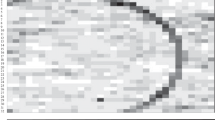Summary
In the analysis of high-purity materials one has always to fall back on multi-stage combined procedures, easy to calibrate, consisting of decomposition, preconcentration, and determination steps, if instrumental direct procedures (e.g. activation analysis, solid state mass spectrometry, optical emission spectrometry) are insufficiently sensitive or too unreliable.
In the first part of this survey general experiences are reported of how such procedures can be optimally applied also to the ng/g-range.
In the second part it is shown by means of four examples how to solve special problems: The examples 1 and 2 deal with the reliable determination of nitrogen and phosphorus in high-purity niobium. Example 3 refers to the spectrochemical detection of metallic impurities (e.g. Bi, Fe, Co, Zn) in high-purity metals after electrolytical preconcentration in a hydrodynamic system. In the 4th example a surface-analytical method, easy to calibrate, is presented which allows the depletion of thin-surface layers (≥10 nm) by anodic dissolution (electrolytic polishing). The element contents are then determined with high precision in the electrolyte. The capability of this method can be proved by measurement of the diffusion profiles of manganese and zinc in copper.
Zusammenfassung
Wenn in der Reinststoff-Analytik instrumentelle Direktverfahren (Aktivierungsanalyse, Festkörpermassenspektrometrie, Optische Emissionsspektrometrie u. a.) unzureichend nachweisstark oder noch zu unzuverlässig sind, muß man auf leicht eichfähige, aus Aufschluß-, Anreicherungs- und Bestimmungsschritte zusammengesetzte Verbundverfahren zurückgreifen.
Im 1. Teil der Übersicht wird über allgemeine Erfahrungen berichtet, wie sich solche Verfahren auch für den ng/g-Bereich optimal gestalten lassen.
Im 2. Teil werden an vier Beispielen spezielle Problemlösungen aufgezeigt: Die Beispiele 1 und 2 behandeln die zuverlässige Bestimmung von Stickstoff- und Phosphorgehalten in Reinstniob. Beispiel 3 bezieht sich auf die spektrochemische Erfassung von metallischen Verunreinigungen (Bi, Fe, Co, Zn u.a.) in Reinstmetallen nach elektrolytischer Voranreicherung im hydrodynamischen System. Im 4. Beispiel wird eine leicht eichfähige oberflächenanalytische Methode vorgestellt, die erlaubt, durch anodisches Lösen (Elektropolieren) dünne Oberflächenschichten (≥10 nm) sukzessive abzutragen und die Elementgehalte im Elektrolyten mit hoher Genauigkeit zu bestimmen. Die Leistungsfähigkeit dieser Methode wird durch Messung der Diffusionsprofile von Mangan und Zink in Kupfer belegt.
Similar content being viewed by others
Literatur
Bingham, R. A., Salter, P. L.: Anal. Chem.48, 1735–1740 (1976)
Dybczynski, R., Tugsavul, A., Suschny, O.: IAEA-Report RL/46, Seibersdorf, 1978
Faßmann, P., Tschöpel, P., Tölg, G.: Veröffentlichung in Vorbereitung
Grallath, E., Ortner, H.: Talanta25, 195–202 (1978)
Grallath, E., Tölg, G.: Mikrochim. Acta (im Druck)
Kleinmann, A., Neeb, R.: Fresenius Z. Anal. Chem.285, 107–109 (1977)
Krivan, V.: Fresenius Z. Anal. Chem.290, 193–211 (1978)
Krivan, V.: Anal. Chem.47, 469–478 (1975)
Liebl, H.: Mikrochim. Acta1978, 241–259
Maier, K.: Diss., TU Stuttgart 1978
Mayer, A., Hofer, Ch., Tölg, G.: Fresenius Z. Anal. Chem.290, 292–298 (1978)
Radermacher, L., Beske, H. E.: Bericht der Kernforschungsanlage Jülich, Nr. 1325, 1976
Rudolph, J., Bächmann, K.: Chromatographia10, 731–743 (1977)
Schulze, K., Fuß, J., Schultz, H., Hofmann, S.: Z. Metallkde.67, 737–743 (1976)
Tölg, G.: Talanta19, 1489–1521 (1972)
Tölg, G.: Talanta21, 327–345 (1974)
Tölg, G.: Pure Appl. Chem.44, 645–670 (1975)
Tölg, G.: Elemental analysis with minute samples; in Wilson and Wilson's comprehensive analytical chemistry, G. Svehla (Ed.), Vol.III. Amsterdam-Oxford-New York: Elsevier Publ. Comp. 1975
Tölg, G.: Naturwissenschaften63, 99–110 (1976)
Tölg, G.: In: Reinststoffprobleme, Bd. V, S. 347–369. Berlin: Akademie-Verlag 1977
Tölg, G.: Mikrochim. Acta, Suppl.7, 1–26 (1977)
Tölg, G.: 26th IUPAC-Congress, Tokyo, 1977. Pure Appl. Chem. (im Druck)
Tschöpel, P.: Plasma excitation in spectrochemical analysis; in Wilson and Wilson's comprehensive analytical chemistry, G. Svehla (Ed.). Amsterdam-Oxford-New York: Elsevier Publ. Comp. (im Druck)
Volland, G., Tschöpel, P., Tölg, G.: Anal. Chim. Acta90, 15–23 (1977)
Watson, A., Kaiser, G., Grallath, E., Tölg, G.: Anal. Chim. Acta100, 413–428 (1978)
Werner, W., Tölg, G.: Fresenius Z. Anal. Chem.276, 103–110 (1975)
Winterkorn, M., Schulze, K., Tölg, G.: Mikrochim. Acta, Suppl.7, 27–39 (1977)
Yang, M.-H., Kaiser, G., Tölg, G.: Int. Symp. on Microchemical Techniques, Davos, 1977; Mikrochim. Acta (in Vorbereitung)
Zief, M., Mitchell, J. W.: Contamination control in trace element analysis. New York: J. Wiley 1976
Author information
Authors and Affiliations
Additional information
Plenarvortrag anläßlich der »2. Tagung für Festkörperanalytik« in Karl-Max-Stadt vom 28. Juni bis 1. Juli 1978
Viele der diesem Bericht zugrunde liegenden Arbeiten wurden in dankenswerter Weise durch Mittel der Deutschen Forschungsgemeinschaft, Bonn und der Dechema, Frankfurt/Main unterstützt.
Rights and permissions
About this article
Cite this article
Tölg, G. Neue Wege zur analytischen Charakterisierung von Reinststoffen. Z. Anal. Chem. 294, 1–15 (1979). https://doi.org/10.1007/BF00694656
Received:
Issue Date:
DOI: https://doi.org/10.1007/BF00694656



